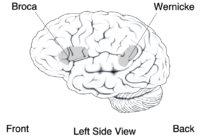
Photo from wikipedia
Speech disorders are very common and disturbing in Parkinson’s disease (PD). They are often gathered under the generic term dysarthria, “a collective name for a group of speech disorders resulting… Click to show full abstract
Speech disorders are very common and disturbing in Parkinson’s disease (PD). They are often gathered under the generic term dysarthria, “a collective name for a group of speech disorders resulting from disturbances in muscular control over the speech mechanism due to damage of the central or peripheral nervous system. It designates problems in oral communication due to paralysis, weakness, or incoordination of the speech musculature” (p. 246). In PD, the following deviant speech dimensions have been reported: monotony of pitch, reduced stress, monotony of loudness, imprecise consonants, inappropriate silences, short rushes of speech, harsh and breathy voice, low pitch, and variable rate. Additionally, reduced loudness, also called hypophonia, has been early described. Speech impairments in PD were reported in the seminal descriptions of James Parkinson, without systematic and precise reference to its timing of appearance, but rather reporting that such impairment occurs “as time and the disease proceed” (p. 5). Gowers reported that “the jaw is usually affected late after the limbs” (p. 38), and dysarthria was not spotted for a while as a main sign among initial symptoms (7 cases among 183 patients with primary parkinsonism; p. 432). “As the disorder progresses, symptoms due to imbalance and dysarthria may gradually appear” (p. 243); this conceptualization of progressive worsening of the symptom probably contributed to define dysarthria as a late symptom. Until recently, dysarthria in PD was presented as part of “other motor abnormalities” (p. 73), disconnected from communication. “The initial defect in the untreated patient is a failure to control respiration for the purpose of speech and there follows a forward progression of articulatory symptoms involving larynx, pharynx, tongue and finally lips” (p. 751). This understanding of a caudorostral progression of the symptom proposed by Selby (1968), from the respiratory system to the larynx and the supralaryngeal articulation, represents contributions of different pathological processes that underlie different aspects of dysarthrophonia, which might have contributed to both restrict dysarthria as a sole motor expression and underestimate respiratory and phonatory signs (e.g., respiratory control deficit, hypophonia, and dysphonia) for the benefit of articulation deficits, major contributors to speech intelligibility decline. The advent of levodopa modified the global picture of speech disorders in PD, leading them to be “relatively neglected,“ with the consensual point of view that dopaminergic medication may improve some speech dimensions and, on the contrary, contribute to the exacerbation of other dimension deficits. Following this L-dopa parenthesis, the advent of DBS brought back a situation similar to that of the era of lesioning subcortical nuclei for the treatment of PD: Managing dysarthria following DBS is often restricted to avoid a worsening of speech disorders and to hope for potential positive effects on speech dimensions such as respiratory control and/or loudness. More than 90% of the patients with PD complain about their low voice intensity and poor quality of communication, leading to a dramatic impairment in quality of life and social isolation. The above-mentioned statements might have been generated upon conceptions that have turned, with time, into misconceptions about speech impairment in PD.
Journal Title: Movement Disorders
Year Published: 2019
Link to full text (if available)
Share on Social Media: Sign Up to like & get
recommendations!